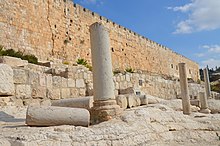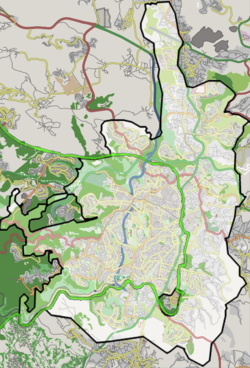 | |
| Location | Jerusalem |
|---|---|
| Coordinates | 31°46′32″N 35°13′52″E / 31.775689°N 35.23104°E |
Aelia Capitolina (Latin: Colonia Aelia Capitolina [kɔˈloːni.a ˈae̯li.a kapɪtoːˈliːna]) was a Roman colony founded during the Roman emperor Hadrian's visit to Judaea in 129/130 CE.[1][2] It was founded on the ruins of Jerusalem, which had been almost totally razed after the siege of 70 CE. This act marked a significant transformation of the city from a Jewish metropolis to a small pagan settlement dedicated to the cult of Capitoline Jupiter.[3]
The population of Aelia Capitolina consisted primarily of Roman legionaries, veterans, and other non-Jewish settlers.[3] Jews were forbidden entrance to the city.[2][4] The city's urban layout was redesigned with broad colonnaded streets, arched gateways, and forums that served as commercial and social hubs. The religious landscape also shifted, with the worship of Roman deities replacing the Jewish religious practices that had been centered around the Temple in Jerusalem.[3] Aelia Capitolina remained a relatively minor city within the Roman Empire, with an estimated population of around 4,000 inhabitants, significantly lower than the population during the late Second Temple period.[3]
The modest colony would change dramatically starting in the early 4th century, when Constantine the Great granted Christianity legal status within the Roman Empire. This led to the construction of the Church of the Holy Sepulchre, laying the groundwork for its eventual transformation into a prominent Christian center during the Byzantine period.[5] The ban on Jews was maintained until the Muslim conquest of Jerusalem in 636. The Aelia part of the name was used in Arabic as Īlyāʾ during the Umayyad Caliphate.[4]
- ^ William E. Metcalf (2012). The Oxford Handbook of Greek and Roman Coinage. Oxford University Press. pp. 492–. ISBN 978-0-19-937218-8.
- ^ a b Shlomit Weksler-Bdolah (December 16, 2019). Aelia Capitolina – Jerusalem in the Roman Period: In Light of Archaeological Research. BRILL. pp. 54–58. ISBN 978-90-04-41707-6.
- ^ a b c d Magness, Jodi (2024). Jerusalem through the ages: from its beginnings to the Crusades. New York, NY: Oxford University Press. pp. 338–339. ISBN 978-0-19-093780-5.
- ^ a b Jacobson, David. "The Enigma of the Name Īliyā (= Aelia) for Jerusalem in Early Islam". Revision 4. Retrieved 2020-12-23.
- ^ Sivan, Hagith (2008). Palestine in late antiquity. Oxford ; New York: Oxford University Press. pp. 1, 190, 194–195, 221. ISBN 978-0-19-928417-7. OCLC 170203843.
